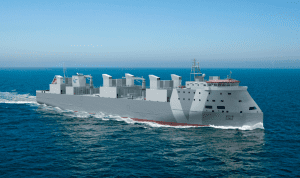The first shipment of Australian cattle to Mexico in nine years is currently enroute to the port of Mazatlán after departing Portland, Victoria last week.
Australian cattle have not been shipped to Mexico since 2016, when Andy Ingle, now principal of Southern Australian International Livestock Services, delivered a one-off shipment of beef breeding cattle to the Central American country.
The current shipment, also facilitated by Mr Ingle, is the first consignment of Australian dairy heifers to be shipped to Mexico since 2010.
The resumption of trade with Mexico represents a positive development for southern dairy heifer breeders following the recent decline in export trade to China.
The major market took over 100,000 dairy heifers annually from Australia until 2024 when tightening economic conditions and declining milk consumption rates led to a 50 percent drop in import demand.
However, the same economic circumstances that have made shipping Australian cattle to Mexico commercially viable again could also present an opportunity for Australian cattle to help the US to rebuild its herd numbers, which are currently at a 70 year low.
That opportunity could be significant for Australian cattle producers, Andy Ingle says, but requires Australian Government ministers to first renegotiate a lapsed import protocol with their US Government counterparts.
Mr Ingle said the consignment of 3000 dairy heifers shipped from Portland last week was enabled by the high price and lack of availability of cattle in the United States, which had created a “small window” to backfill the requirements of some dairies in Mexico which needed cattle now.
Mexico relies on trucking dairy cattle from the US to supplement its herd requirements.
“We are helping to fill a void for a small number of cattle requirements that they are simply unable to source from the US because of a lack of availability,” Mr Ingle said.
“But certainly it reflects what is also a major opportunity for Australian cattle, both breeder and feeder, to be shipped to the US if the Australian Government is able to renegotiate the protocol.”
Beef Central understands that a health protocol enabling cattle trade from Australia to the US lapsed relatively recently and must now be renegotiated.
Ongoing discussions with members of Australia’s livestock export trade in recent months indicate that if that protocol were in place, the economics of shipping Australian cattle to the US would be commercially favorable, due to high cattle prices in the US and the lower Australian dollar.
Mexico and Canada both supply large numbers of feeder and slaughter cattle into the US production system every year, exporting 1.2 million and 730,000 cattle respectively in 2023.
Imported cattle from both sources are set to be subjected to substantial tariffs—as high as 25 percent—starting March 4, under the shock tariff regime announced by US President Trump early last month.
Mr Ingle cautioned that the opportunity to export cattle from Australia to the US “would not be there forever” but described it as potentially as significant for Australia’s live cattle export sectoras the opportunity presented by the emergence of the Vietnam export trade 10 years ago.
“We would urge industry and government to do all they can to see these protocols reinstated as a matter of priority,” Mr Ingle said.
He noted that there are US buyers “commercially ready” to take Australian cattle if the Australian Government can act to renegotiate the trade protocol.
Another prominent export industry source told Beef Central last month that the opportunity with the US is substantial for both countries. “On paper it absolutely works, with the Australian cattle price plus shipping, the margin is large,” the source said.
Australian Council of Livestock Exporters CEO Mark Harvey-Sutton told Beef Central that the renewal of trade to Mexico was very welcome news.
“We think that’s a tremendous development and an exciting new market opportunity,” he said. “It shows that the Australian industry is very innovative and always open to new markets.”
“It also demonstrates the role we can play in countries looking to rebuild their herds or to develop their production capacity. It is a responsibility we have as an industry and shows once again Australia’s leadership in exporting livestock.”

